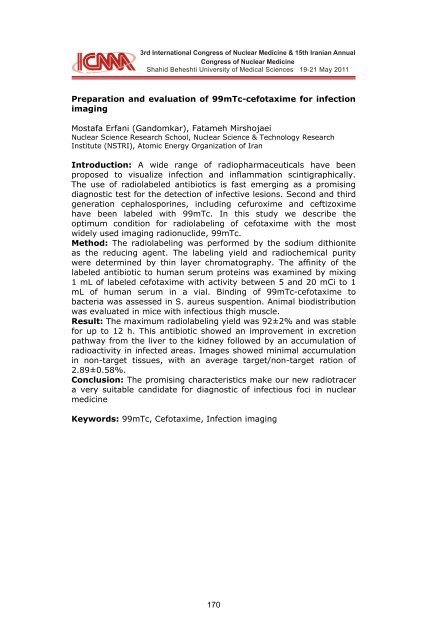Panel Disdussion
Panel Disdussion
Panel Disdussion
You also want an ePaper? Increase the reach of your titles
YUMPU automatically turns print PDFs into web optimized ePapers that Google loves.
3rd International Congress 3rd International of Nuclear Congress Medicine of Nuclear & 15th Medicine Iranian Annual & 15th Iranian Congress Annual of<br />
Nuclear Congress Medicine of Nuclear Medicine<br />
Shahid Beheshti Shahid Beheshti University University of Medical Sciences of Medical 19-21 Sciences May 201119-21 May 2011<br />
Preparation and evaluation of 99mTc-cefotaxime for infection<br />
imaging<br />
Mostafa Erfani (Gandomkar), Fatameh Mirshojaei<br />
Nuclear Science Research School, Nuclear Science & Technology Research<br />
Institute (NSTRI), Atomic Energy Organization of Iran<br />
Introduction: A wide range of radiopharmaceuticals have been<br />
proposed to visualize infection and inflammation scintigraphically.<br />
The use of radiolabeled antibiotics is fast emerging as a promising<br />
diagnostic test for the detection of infective lesions. Second and third<br />
generation cephalosporines, including cefuroxime and ceftizoxime<br />
have been labeled with 99mTc. In this study we describe the<br />
optimum condition for radiolabeling of cefotaxime with the most<br />
widely used imaging radionuclide, 99mTc.<br />
Method: The radiolabeling was performed by the sodium dithionite<br />
as the reducing agent. The labeling yield and radiochemical purity<br />
were determined by thin layer chromatography. The affinity of the<br />
labeled antibiotic to human serum proteins was examined by mixing<br />
1 mL of labeled cefotaxime with activity between 5 and 20 mCi to 1<br />
mL of human serum in a vial. Binding of 99mTc-cefotaxime to<br />
bacteria was assessed in S. aureus suspention. Animal biodistribution<br />
was evaluated in mice with infectious thigh muscle.<br />
Result: The maximum radiolabeling yield was 92±2% and was stable<br />
for up to 12 h. This antibiotic showed an improvement in excretion<br />
pathway from the liver to the kidney followed by an accumulation of<br />
radioactivity in infected areas. Images showed minimal accumulation<br />
in non-target tissues, with an average target/non-target ration of<br />
2.89±0.58%.<br />
Conclusion: The promising characteristics make our new radiotracer<br />
a very suitable candidate for diagnostic of infectious foci in nuclear<br />
medicine<br />
Keywords: 99mTc, Cefotaxime, Infection imaging<br />
170
















